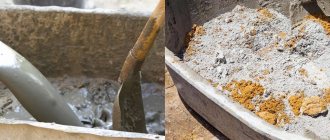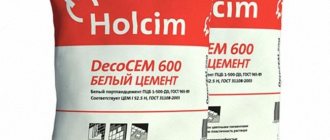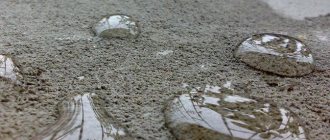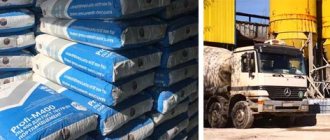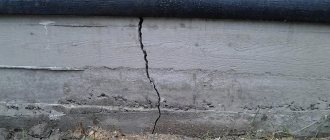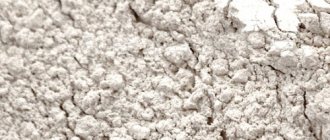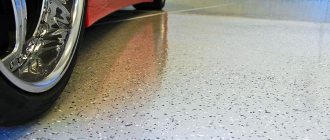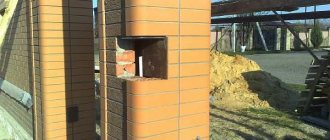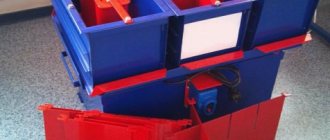As soon as the construction season opens, markets experience an influx of buyers. Of course, every buyer wants to save money and purchase building materials at a low price. At the time of purchase, the main thing to remember is that good cement is a guarantee of the strength of the future object.
There are often cases when, when buying cement in bulk, buyers are left deceived. It is quite difficult to identify poor quality material. Even when purchasing a product in original packaging, there is no guarantee that it will be of truly high quality. To avoid getting into such a situation, you need to know the most commonly used schemes that sellers use.
The most common deception schemes
If cement is supplied for sale from a factory, then in 99% of cases the seller will not carry out any fraud with it, because all the necessary documentation is provided for such a product. Another thing is small campaigns, which much more often use various tricks that an inattentive or inexperienced buyer does not recognize:
- Adding air to the mixture. The same rule applies here - at large locations, automatic packaging lines are installed, with scales on them. Cement is passed through them and such deception is excluded in this case. Small companies pack manually and do not always weigh them. Even if the material is ultimately bagged, it can easily be found to be 4.5 to 10 kilograms short of the stated weight.
- Inflating the brand. Once again, the plant's production lines allow for detailed control. The mixture undergoes an assessment and a series of tests, including compliance with GOST. Private companies often determine a brand simply by eye. And with such a check, it is quite possible that the real brand will be overestimated. When purchasing such cement, it will not be possible to immediately determine its brand on the spot, and discrepancies can only be discovered after preparing and laying the batch.
- Mixing with low-quality additives. The cement must contain a certain ratio of mineral additives, without the slightest deviation from the norm. Raw materials, whether chemical or mineralogical, directly affect the quality of the product. But many unscrupulous sellers add mineral additives to cement that do not have astringent properties. Next, they sell a cheap and low-quality product at the price of an expensive one. Because of this cement, the mortar made will be much lower in quality and characteristics. For example, a packer can add up to 40-50% mineral powder, ground slag, and other additives and impurities to the mixture. The result is a low quality product that is not suitable for many types of buildings where a deceived buyer could use it. It is difficult to check this method of deception when purchasing.
- Identical packaging. This scheme is the oldest and is used quite often, but some still use it quite successfully. An unscrupulous seller is trying to profit from a well-known brand. The seller makes packaging in the same color scheme as a well-known brand, replaces one or more letters in the name of the latter and puts it up for sale for a small price. An inattentive buyer sees a familiar package, his vigilance is further lulled by the low price, after which he makes a purchase without reading the name.
- Recycling of expired or stale cement. Cement from the factory is packaged in polyethylene and special bags, which ensures the safety of its storage. If the product was transported and stored according to all the rules, then it may not lose its properties after shipment for a couple of months. But the handling and storage conditions are not always met, which leads to Portland cement tracking and turning into hard lumps. Such cement is considered unsuitable for use and therefore cannot be sold. However, deceptive sellers take unusable cement and crush it so that it becomes marketable again. But the characteristics of such a product remain at a low level. The use of such cement in the foundation will lead to its destruction literally in 1-2 years.
You can avoid such troubles by visiting only trusted stores, and, if possible, purchasing products directly from the factory, checking all documents for concrete and the appearance of the goods.
CEMENT QUALITY CONTROL
March 14, 2018
Most building materials and structures for critical facilities undergo multi-stage quality control. For complete confidence in quality, the documentary support of any material from the manufacturer to the processing, assembly and manufacturing enterprises is checked. Responsibility for the quality of many materials falls on their manufacturers, for example, a concrete supplier is responsible for the quality only of its products, independently checking the parameters of the source materials - sand, cement, water, additives and crushed stone.
Visual assessment of cement and checking for the absence of lumps is part of the simplest express analysis of this material
The final quality check is guaranteed by laboratory analysis. For example, cement can be subjected to such analysis. This is what they do when a construction site has its own mortar-concrete unit. Laboratory analysis is also used on relatively small objects when doubts arise about the quality of materials or their compliance with accompanying documents.
In some cases, when using materials for non-responsible structures or to make decisions about ordering laboratory analysis at a construction site, express methods of simplified quality control may be used. There are simplified express methods for checking the quality of cement.
Adulterated and damaged cement
Cement from a dubious supplier or stored in unsuitable conditions, as well as having unusual external features, can be quickly checked without any equipment. In addition to making test samples of concrete or mortar, which require several days or even more to test, a faster method can be used, requiring less than an hour.
Before undertaking such a rapid check, you need to evaluate the appearance and physical condition of the cement:
- it must be a uniform dusty composition of significant weight
- the presence of lumps should alert you - if such lumps are hard and there are many of them throughout the volume, then the cement was most likely in a humid environment and some of it had time to react with water. Such cement, even if it meets the declared brand, will never provide the required strength in solution
- The weight of the cement, its unusual color and other features may attract attention. Adulterated cement may contain neutral additives and ballast, making this material practically unsuitable even for non-critical work.
Express method for approximate assessment of cement quality
The essence of this method is to mix cement with water and salt-alkaline additives, which act as catalysts and hardening accelerators. Such water with additives is also available in ready-made form - this is the well-known mineral water “Essentuki”.
With caution, with the protection of hands, skin and eyes, a solution of questionable cement is mixed in the usual proportions (1: 3) with mineral water. Salt-alkaline water significantly intensifies the process of setting cement and gaining strength. A mixed small portion of cement, formed in the form of a flat cake, heats up significantly and the resulting form hardens in literally 10 minutes.
Cement with a large amount of ballast (adulterated) will not harden in 10 minutes and will not heat up. This cake will not change its state within an hour.
At the end of the express check, you can confidently make a decision about the fate of such cement and its supplier - contact a certified laboratory, where a comprehensive analysis will be obtained, after which you can make claims to the seller.
What inscriptions should be on the packaging?
The very first thing you need to look at on cement packaging is the inscription GOST 10178-85 or 31108-2003. A possible option is GOST 32208 3026. The first option is older requirements for the GOST, but they are still relevant today. According to the first specified guest, the marking PTs (Portland cement) must be indicated on the bag. Next, the brand must be indicated. It shows certain properties of cement, for example, the inscription M500 will indicate that after hardening the cement will be able to withstand a pressure of 500 kg/cm2. A lower number indicates lower performance. A certain brand of cement is suitable for each type of object.
GOST also requires that the percentage of additives be indicated on the packaging. For example, D0 indicates the complete absence of additional impurities, and D20 (or another figure) indicates a corresponding content of no more than 20% of additional components.
The next GOST under consideration is GOST 31108-2003, it is in compliance with the European standard called EN 197-1. Some production facilities switched to this GOST in 2008. It also makes it clear that the product is of high quality. According to its requirements, the following markings must be indicated on the packaging:
- CEM I (CEM I) is Portland cement without any additives.
- CEM II (CEM II) - indicates that mineral additives are present in Portland cement.
- CEM III (CEM III) is a special designation for Portland slag cement.
In addition, the minimum compressive strength values for 28 days must be indicated. It is after this time that brand strength reaches its values. Measured in MPa, indicated in digital value. Example - 32.5, 22.5, etc. The subclass of the material is also indicated on the bag, and specifically the indicators of its compressive strength on the second and seventh days. There are two markings - B for fast-hardening and H for normal-hardening.
Any deviation from GOST standards and the absence of any mandatory markings on the packaging makes it clear that this is counterfeit.
Transshipment bag or factory packaging
Factory packaging
Cement in factory packaging is more expensive, but in this case you can be sure that this is exactly the material you wanted to buy and use. Such bags indicate the address of the factory and its contacts. Knowing them, you can easily check the existence of such a plant in reality and even apply there for confirmation of the fact that the company’s products are sold in a specific store.
Helpful advice! Be sure to weigh the bags. Their weight should be equal to or slightly higher than that indicated by the manufacturer on the packaging. Productions are rounded up.
In addition, manufacturers always pack the product in a craft bag, which consists of 4 layers. If, upon opening the purchased product, a smaller quantity is discovered, the product is marketable. Fewer layers cause a greater chance of air ingress and product damage.
Transshipment
Transshipment refers to market options for packaging cement. Cement is ordered at the factory and delivered in bulk, after which the seller performs manual packaging. Its consequence is a smaller number of layers and underweight of the product relative to the figure indicated on the packaging.
There is also one fine thing to do. An unscrupulous manufacturer often indicates to the manufacturer the plant from which he received the cement. By law, he is required to indicate his information as a cement packer. Pay attention to the corresponding inscriptions on the bags. If cement was purchased in Kazan, and packaging took place in Korolev, you should be wary of the product.
Look carefully at the price too. The desire to save money is good, but if the price is much lower than the market price, you should think about whether it is cement. Or maybe just lower quality. Don't be fooled by discounts or other one-day promotions. They may turn out to be a mere distraction. If you decide to take such cement, be sure to check the presence of the GOST inscription and other characteristics.
Useful tips
Below are a few more tips to help you avoid being deceived:
- If you purchase PC in bulk, contact the factory directly. Intermediaries do not work for free, so they will most likely offer you diluted mixtures.
- . Be sure to ask the seller about the cement storage method. If you hear something vague in response, if the seller says that the mixture was stored somewhere on the street, then you should not buy such a product. The seller must always store cement in proper conditions.
- If you purchase cement in bags, be sure to take special scales with you, which you will personally use to check the weight of the package. If there is a discrepancy of more than 1 kg, you are looking at low quality products.
- If you buy a large batch of goods, you will resort to checking the quality of the PC through an examination. If the product turns out to be of poor quality, you will lose much more by rebuilding the cracked object than by examining it alone.
By following these tips, you will be able to recognize the products of an unscrupulous seller. Check everything yourself and don’t be fooled by the seller’s words, he just wants to sell you the product. It is always better to spend money on quality products than to overpay when an object built from poor material falls apart.
How to properly test cement?
In order to check the quality of cement, you will have to purchase a small batch - one bag, and subsequently, if the result is positive, order an industrial batch from this particular retail outlet, from this particular manufacturer, best of all from this particular supply.
First of all, evaluate the type of powder. It should be dry, gray-green in color, flow through your fingers like water and have no hard lumps. At the same time, it’s okay if there are lumps that crumble into powder when pressed with your fingers.
If the lumps break up into smaller solid lumps, the cement is either expired or was in conditions of high humidity and most likely has lost a significant part of its activity
Such material can only be used as a filler. Also, when purchasing cement in bags, you should feel the corners of the bags and the bag itself - there should be no hardening in them, and the bag of cement itself should be “live” and not “stone”.
